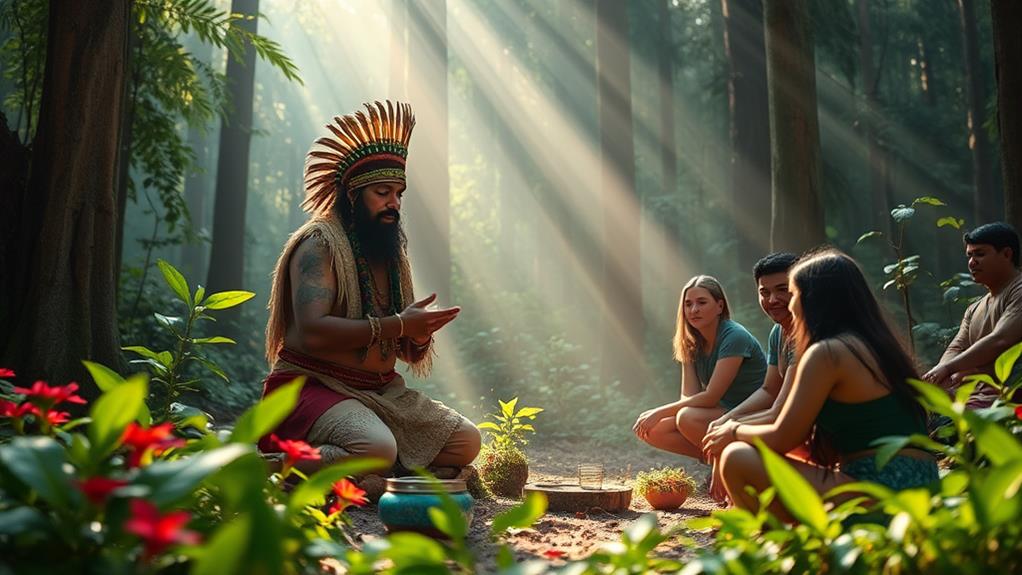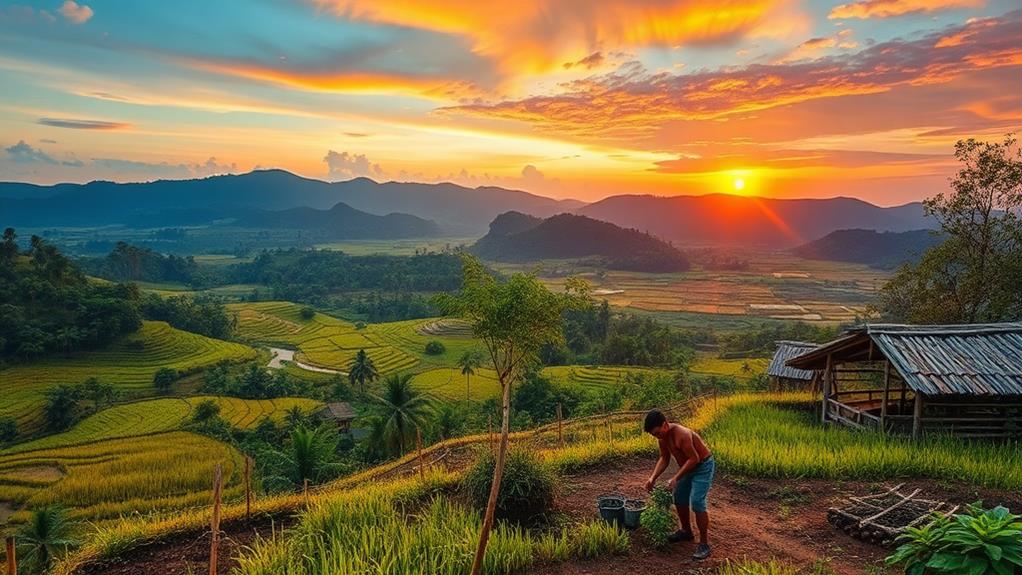Filipino spirituality is deeply rooted in nature, where reverence for ancestors meets environmental responsibility. This connection is evident in the belief in Anito, or spirits, that inhabit every aspect of the natural world and guide human interactions with it.
For instance, community rituals before gathering or hunting emphasize gratitude and balance to maintain harmony with nature.
Shamans, or Babaylan, play a vital role as intermediaries, nurturing the spiritual relationship between humans and nature. They facilitate rituals and ceremonies that promote respect and reciprocity with the natural world.
Sacred sites like Mt. Banahaw hold significant meaning, demanding respect and care to maintain the delicate balance of nature.
This holistic view of nature and spirituality fosters a communal identity that thrives on nature's wisdom and protection.
By embracing this connection, Filipinos can promote environmental stewardship and preserve their cultural heritage.
Overview of Filipino Spirituality

Filipino spirituality is deeply rooted in a connection to nature and ancestral spirits. This connection is evident in the significance given to every mountain, tree, and spring, which holds importance beyond its material value.
The veneration of ancestral spirits, particularly the Anito, is a key aspect of Filipino spirituality. Anitos serve as intermediaries between the living and the divine, and rituals and sacrifices are performed to appease them and seek blessings.
Indigenous spiritual practices, such as those of the Aetas, prioritize gratitude and respect for the environment. For example, the Aetas' Kagon ritual aims to exorcise negative influences and ensure harmony with the divine.
Despite the influence of foreign religions, the reverence for Anitos hasn't diminished; instead, it has blended with Catholic beliefs, illustrating a syncretism that enriches Filipino spirituality.
This blend highlights the intersection of nature and spirituality in Filipino culture, emphasizing that every ritual and offering is a profound acknowledgment of one's connection to the ancestral spirits that watch over the land.
Spiritual Beliefs and Nature
In the Philippines, indigenous communities share a profound spiritual connection with nature. This bond is rooted in animism, where every aspect of nature is believed to be inhabited by spirits known as Anitos.
Spiritual leaders guide rituals that honor these spirits, reinforcing the idea that nature and the divine are intertwined.
Rituals are essential acts of respect towards the Anitos. For groups like the Aetas, rituals performed before hunting or gathering aren't mere traditions; they ensure a fruitful harvest.
Natural features like sacred springs, ancient trees, and towering mountains hold significant cultural value, as they're seen as homes to these spirits.
Disturbing these spaces can lead to illness or disaster, reflecting a deep understanding of the interconnectedness of nature and community well-being.
Mt. Pinatubo serves as a powerful symbol in this spiritual landscape. It's viewed as a resting place for ancestral souls and a site where the supreme being, Apo Malyari, influences daily life.
Through rituals and offerings, indigenous Filipinos demonstrate reverence for nature and the Anitos that inhabit it.
Role of Shamans in Communities

Shamans are the spiritual backbone of indigenous communities, maintaining cultural and spiritual continuity. In Indigenous Filipino societies, shamans act as mediums, connecting the physical world to the realm of spirits and deities. They possess expertise in various subtypes, such as healing, divination, and sorcery, allowing them to perform essential rituals that uphold community unity and wellness.
Babaylan, a prominent type of shaman, facilitates communication within tribes, addressing spiritual needs and challenges. They counteract witchcraft and supernatural curses, redefining the negative connotations commonly associated with witchcraft in other cultures. By employing deep knowledge of rituals and spirituality, they restore balance and harmony.
Rituals led by shamans often venerate ancestral spirits and nature deities, emphasizing the profound connection between Filipino spirituality and the natural environment.
As communities gather for these ceremonies, shamans guide spiritual practices and reinforce cultural identity, ensuring that traditions are honored and passed down through generations. In this way, shamans remain pivotal in nurturing the spiritual landscape of Indigenous Filipino life.
How Does Filipino Spirituality Incorporate Ancestral Spirits and Nature?
Filipino spirituality holds the role of ancestral spirits in high regard, believing that they continue to influence the living. Ancestral spirits are thought to offer guidance and protection, making them an integral part of spiritual practices. Furthermore, nature is also revered, with the belief that natural elements are inhabited by spirits.
Sacred Sites and Objects
Sacred sites and objects hold significant spiritual importance in Indigenous communities, where nature and spirituality are deeply intertwined.
These sacred sites often feature natural elements like mountains, springs, and trees. For example, Mt. Banahaw is considered a holy place by many devotees, and the Tagbanwa people believe their sacred mountains are inhabited by deities and ancestral spirits that guide their rituals and cultural practices.
Certain objects, such as balete trees and anthills (punso), are revered in these communities because they're believed to house spirits that play crucial roles in daily life. The bulul, a rice deity figure, is crafted to ensure agricultural abundance, highlighting the deep connection between spirituality and nature in Filipino beliefs.
The respect for these sacred sites and objects is paramount, as disturbing them is thought to invite negative consequences.
This reverence underscores the intricate relationship between Indigenous communities and their environment, emphasizing that spiritual significance is deeply rooted in the natural world.
Every mountain, tree, and ritual embodies a story of connection, respect, and shared existence with the spirits of nature.
Environmental Stewardship and Practices

Indigenous Filipino Spirituality and Environmental Stewardship
In Indigenous Filipino communities, a deep respect for nature is rooted in their spirituality, influencing daily environmental practices. The Aetas, for example, perform rituals and offerings to their anito spirits before hunting or gathering, demonstrating a commitment to balance and gratitude. This respect for the natural world is seen as sacred, reflecting a deep understanding of the interconnectedness between the spiritual and environmental realms.
When disturbances occur, spiritual mediums intervene to appease the anito, highlighting the interconnectedness between the spiritual and environmental. This relationship isn't limited to the past; it continues to inspire community initiatives led by church leaders, who advocate for sustainable practices and reforestation.
They recognize the moral imperative to care for creation, particularly in the face of climate change crises. The Catholic Church's growing emphasis on environmental stewardship parallels these indigenous practices, encouraging individuals to view themselves as caretakers of the Earth.
By combining traditional and contemporary beliefs, Filipino spirituality fosters a holistic approach to environmental stewardship, urging communities to respect nature while adapting to modern challenges. This blend of indigenous practices and religious beliefs drives a deeper commitment to preserving the environment for future generations.
Questions and Answers
What Is the Filipino Nature Spirit?
Filipino nature spirits are rooted in Anito beliefs, which recognize nature deities inhabiting sacred landscapes.
These spirits play a crucial role in indigenous practices, embodying the connection between people and the environment.
Rituals often aim to maintain harmony with these entities, ensuring respect for the land and its resources.
For instance, the Tagalog people believe in the diwata, gentle spirits dwelling in forests and mountains, while the T'boli people of Mindanao revere the buwan, a moon spirit controlling the cycles of nature.
Engaging with these traditions offers a holistic perspective on the intricate relationship between humans and the natural world.
What Is the Spirituality of the Philippines?
The spirituality of the Philippines is deeply rooted in cultural practices, emphasizing ancestral worship and indigenous beliefs. These beliefs are reflected in rituals honoring ancestors, which demonstrate a profound respect for lineage. For instance, in some Filipino communities, families gather to offer food and drink to their ancestors during the All Souls' Day celebration, believing that this will bring blessings and protection.
This spirituality also promotes environmental stewardship. Many rituals connect the sacredness of nature with daily life, encouraging individuals to respect and care for the natural world.
For example, some indigenous groups in the Philippines perform rituals to ensure a bountiful harvest, which involves offering prayers and sacrifices to the spirits of the land and their ancestors. By doing so, they recognize the interconnectedness of people, ancestors, and the natural world.
What Are the Three Main Themes of Spirituality as Viewed by Filipinos?
Three main themes of spirituality emerge in Filipino culture: cultural rituals, ancestral beliefs, and community connection.
Cultural rituals play a significant role in strengthening bonds among individuals. For instance, the Filipino tradition of Simbang Gabi, a series of nine dawn Masses leading up to Christmas, brings families and friends together to celebrate their faith and cultural heritage.
Ancestral beliefs guide daily actions and decisions in Filipino spirituality. The respect and reverence for ancestors are deeply ingrained in Filipino culture, influencing daily life and decision-making.
For example, many Filipinos seek guidance from their ancestors when making important life choices, such as choosing a career or getting married.
Community connection is a vital aspect of Filipino spirituality. This connection is fostered through a deep commitment to both the land and the community.
Environmental respect is woven into this element, as Filipinos believe in living in harmony with nature. This holistic approach ensures that spiritual practices are passed down through generations, maintaining a vibrant cultural identity.
What Is the Nature of Filipinos?
Filipinos prioritize community values, which are deeply rooted in their culture. These values emphasize kinship and cooperation, encouraging individuals to work together for the greater good.
For example, the concept of "bayanihan" (communal unity) is a common practice in rural areas, where neighbors help each other build homes or harvest crops.
Their cultural heritage is rich in traditions, reflecting the wisdom of their ancestors. These traditions guide Filipinos in living ethically and being socially responsible.
For instance, the tradition of "pagmamano" (respect for elders) teaches younger generations to value the wisdom and experience of their elders.
Environmental stewardship is crucial to Filipinos, as they view the land as a shared resource. They believe in preserving natural resources for future generations.
For example, the indigenous practice of "kaingin" (shifting cultivation) ensures that the land isn't overexploited, allowing it to replenish itself for future use.
These interconnected beliefs shape the daily lives of Filipinos, fostering a holistic perspective that respects both the community and the natural world.